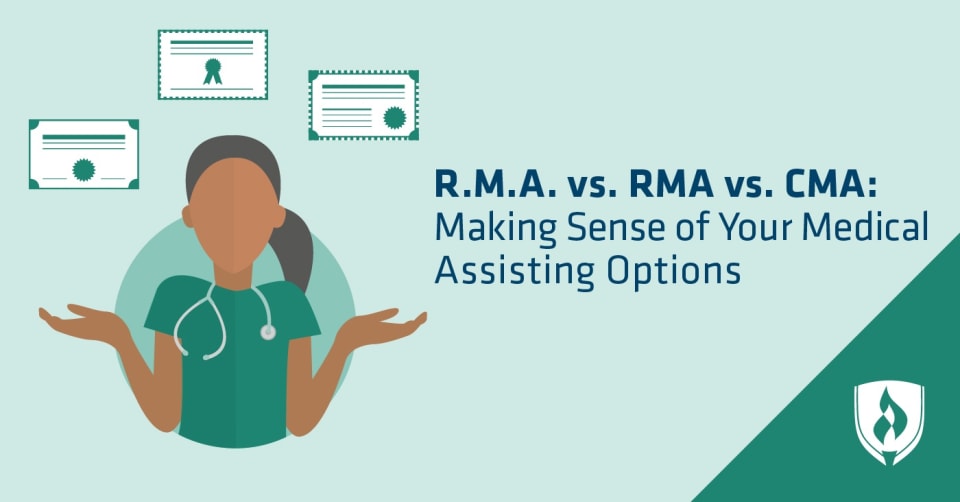RMA (ARMA) vs. RMA vs. CMA: Making Sense of Your Medical Assisting Options
By Will Erstad on 09/21/2020

Professional certifications and credentials are a common sight in healthcare. It seems that no matter the healthcare role, there’s a good chance you’ll find someone in that position with a smattering of abbreviations surrounding their name that you may or may not recognize. Often these signify that this person has earned a professional credential after completing their college coursework or training—and that’s true for many medical assistants as well.
If you’re just getting started on the path to becoming a medical assistant, you might be wondering what the fuss is about. And the question of RMA (ARMA) vs. RMA vs. CMA might be making your head spin. Which of these medical assisting options makes sense for you? We’re here to help you understand your options.
Why are medical assisting credentials important?
If you’ve completed your medical assistant courses and training, you should have everything you need to perform the job well. So why should you care about earning a professional credential on top of that? It’s true that for some roles, professional credentials and certifications after college may be little more than an easy way to highlight and verify some specialized expertise on a resume. But there’s a bit more to the story when it comes to medical assisting credentials.
The truth is that employers have an important incentive to hire medical assistants with the right credentials. Rules governing the Center for Medicare & Medicaid Services require anyone who enters medication, laboratory or radiology orders into an electronic health records system to be either a “credentialed medical assistant” or “licensed health care professional” in order to meet what are known as meaningful use guidelines.
Healthcare providers who meet these guidelines are eligible to receive financial incentives—and that can substantially impact their bottom line. Long story short, employers have a good reason to care about these credentials, and that means medical assistants should care as well.
So what does it mean to be a “credentialed medical assistant” for these purposes? Medical assistants must earn a credential recognized by the National Commission for Certifying Agencies (NCCA) to be approved. This is where things can start to get confusing—so let’s take a closer look at some of the common options you may have seen.
What are some common medical assisting credentials?
There are a handful of medical assisting credentials out there, and some are more recognizable than others. Keep reading for a breakdown of the most common options.
Certified Medical Assistant (AAMA)®
Description: The Certified Medical Assistant credential is awarded by the American Association of Medical Assistants (AAMA). This credential is recognized by the NCCA and does count toward fulfilling the requirements for meeting meaningful use guidelines. This nationally-recognized professional certification verifies medical assistants’ knowledge in key areas of practice and overall healthcare delivery.
Requirements: To earn the Certified Medical Assistant credential, you’ll need to first meet eligibility requirements. There are three primary paths to eligibility, the most straightforward involving the completion of a Medical Assisting program that is accredited by either the Commission on Accreditation of Allied Health Education Programs (CAAHEP) or by the Accrediting Bureau of Health Education Schools (ABHES). Once eligibility requirements are met, CMA applicants will need to sit for and pass a certification exam consisting of 200 questions covering clinical, administrative and general medical assisting competencies and knowledge.
Registered Medical Assistant (AMT)
Description: The Registered Medical Assistant (RMA) credential is awarded by American Medical Technologists. Like the CMA, this credential is recognized by the NCCA and does count toward fulfilling the requirements for meeting meaningful use guidelines. As another nationally-recognized professional certification, the Registered Medical Assistant designation verifies medical assistants’ overall knowledge of medical assisting practices.
Requirements: To earn the Registered Medical Assistant credential, there are several requirements you’ll need to meet. Assuming you’re applying as a Medical Assisting student or recent graduate from an accredited program or institution, you’ll need to provide official academic transcripts to apply. From there, you’ll need to sit for and pass an exam. The exam is 200-210 questions covering three focus areas—clinical, administrative and general medical assisting knowledge.
Registered Medical Assistant (ARMA)
Description: Unlike the other two on this list, this designation from the American Registry of Medical Assistants is not a credential recognized by the NCCA and does not fulfill the requirements for meeting meaningful use standards at this time. This designation simply means your name is on a third-party registry of medical assistants that can be verified by employers. While it’s not harmful to be on this registry, employers who are looking to meet CMS’ meaningful use requirements will still want to verify you’ve earned either of the other two credentials as well.
Requirements: According to the ARMA, requirements for inclusion on this registry are:
- Must graduate from an approved, accredited high school or equivalent
- Copy of Social Security card with signature
- Copy of photo ID with signature
- If needed, legal documentation used to substantiate any discrepancies between these documents.
Additionally, they may require a copy of your diploma from an accredited medical assisting institute, a copy of transcripts from your academic program, a letter of recommendation from your employer or proof of employment as a medical assistant. The specifics of this can vary depending on your background, so it’s worth reaching out to ARMA directly with questions if you choose to pursue this option.
What else should you know about medical assisting credentials?
There’s certainly a lot to digest here already, but there are a few more questions or concerns you may have:
When should I plan on applying for and taking these exams?
If you’re a student considering earning either the CMA (AAMA) or RMA (AMT) credential, you’ll likely want to get the process started toward the end of your Medical Assisting program. Remember, many healthcare providers may place a premium on hiring credentialed medical assistants, so the sooner you become a credentialed medical assistant, the better. That said, some employers may be ok with a short grace period for new medical assisting hires who have plans to become credentialed in the near future.
What if I don’t want to earn one of these credentials?
You certainly have the option to not earn one of these credentials, but it may not be a wise decision. Rasmussen University Medical Assisting instructor Traci Forguson explains that you may be able to find medical assistant work at small clinics that do not use electronic medical records systems or participate in the meaningful use incentives program, but that may be a challenge.
“From what I see in my area, the graduate needs to be credentialed in order to work for a large healthcare company,” Forguson adds.
Another aspect to consider is your ability to retain what you’ve learned in Medical Assisting courses. These courses generally align with what you’ll find on either the CMA or RMA exam, so it might be best to get it taken care of right away. Even if you find an employer who doesn’t require one of these credentials, taking this step now will likely be easier on you than trying to revisit it later on if you need to look for employment elsewhere.
How much do these medical assisting credential exams cost?
Both the CMA (AAMA) and RMA (AMT) credential exams include examination fees. The RMA has a $120 exam fee, while the CMA has a $125 exam fee per attempt. The good news for Rasmussen University Medical Assisting students is that these fees are covered within the cost of your program, so your first attempt comes at no additional charge.1
Which medical assisting credential is best for me?
With all this in mind, you may be wondering which of these credential options is best to pursue. Both the CMA (AAMA) and RMA (AMT) credentials have their proponents and you may find one or the other to be more common in your area. Forguson, an RMA, says that while you may see many job postings seeking out “Certified Medical Assistants,” employers are typically flexible.
“I have spent time in three different states educating medical assistants and I have found that employers really just want a ‘credentialed’ medical assistant,” Forguson says.
That means both the CMA credential from the AAMA and RMA from AMT are solid options for satisfying that criteria. Choosing between the two may come down to eligibility specifics regarding your program—something an advisor can help you navigate.2
Move forward with confidence
With such similar names, figuring out the differences between these options can certainly get confusing. By now you should have a stronger understanding the of value of becoming a credentialed medical assistant and why employers care—as well as how that’s different from being included on a medical assistant registry.
Of course, the first step before earning a credential is to develop the essential skills and information needed for a successful career as a medical assistant. If you’re ready to get started, visit the Rasmussen University Medical Assisting program page to learn more.
1The application fee for each qualified student’s first exam attempt is included in the total program costs. Should you need to take the exam more than once to receive a passing score, you will be responsible for all subsequent exam application fees. Contact an admissions advisor to determine the best exam option for you.
2Graduates of our programmatically-accredited Medical Assisting programs can sit for the CMA or RMA (AMT) exam; graduates of our non-programmatically-accredited Medical Assisting programs can sit for the RMA (AMT) exam. Visit the accreditation page for full details regarding programmatic accreditation.
Certified Medical Assistant is a registered trademark of the American Association of Medical Assistants.




